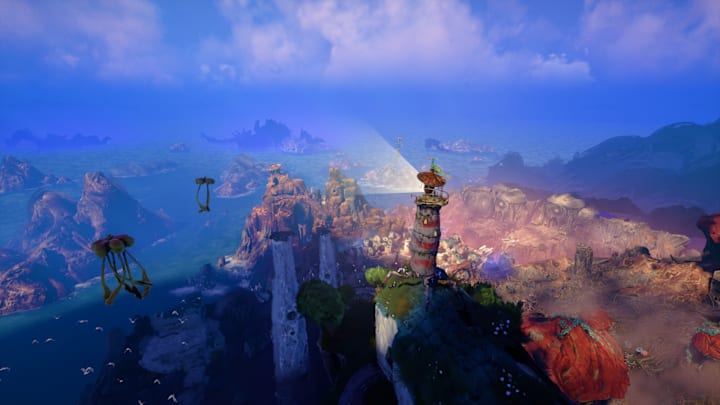Keeper review: Weird and wonderful with a few imperfections
By Ryan Woodrow

I’ve always had a soft spot for Double Fine. It’s true that its output is quite hit-and-miss, but that’s only because it’s one of the few developers out there who are willing to just try anything. When it was brought under the Xbox Game Studios banner, there was a fear that it’d be forced into playing it safe, and sure enough, its first release under Xbox was Psychonauts 2 — far and away the safest bet the studio had on hand.
Thankfully, many of those fears can now be allayed, as Keeper is here to show that Double Fine can still come up with game ideas as weird as it ever has. You play as the Keeper, a sentient lighthouse creature whose light can repel the corruption encroaching upon the world. A cute bird/fish creature lands on your head, and so your quest begins to reach the distant mountain top to cleanse the world of this corruption once and for all.
You immediately get a great sense of character injected into what is essentially an inanimate object. The game’s aesthetic strikes a great balance between somewhat realistic beauty and cartoony elements that allow you to appreciate all the little cracks and crevices chipped into the lighthouse’s body, while still adding elements like little metal eyebrows over its central light so it can emote.
The storytelling is all “show don’t tell”, and it’s excellently done. There isn’t a single word of dialogue, but you get a proper sense of everything. The Keeper will spend the first few minutes constantly losing its balance and falling over because it’s only just started walking for the first time, which is sweet and endearing, though also a little unsettling, as you do so while walking through a graveyard of the Keepers who came before you and perished.
That balance of lighthearted and dreary tone is Keeper’s greatest trick. The world is bright, colorful, and full of whimsy, but it can also become oppressive and gloomy at a moment’s notice. It’s not just the corruption that brings this change either; sometimes the environment is peril enough to bring that sense of danger as you puzzle-platform your way up the mountain.
It does a great job of taking you through different segments of this world, introducing a puzzle mechanic, riffing on it for a while, and then moving swiftly on once it’s got all it can out of it. It makes this three-hour game move along at a perfect pace, as you’re never stuck on one idea for too long, both aesthetically and mechanically.
The puzzles aren’t particularly difficult, but each one has fun ideas injected into it that help you appreciate it on a level outside of the pure mechanics. One of the best segments sees you activate nodes that move you backwards and forwards through time. Mechanically, this makes for fun puzzles about changing the environment around you, but what makes it much more enjoyable is how it represents this. The first time you move backwards through time, you’ll see your lovely bird companion suddenly pop back into being an egg, or going forwards will have them disintegrate into bones and become a ghost until you return to the present.
It doesn’t just stick with one format, either. I was quite surprised to find that halfway through, you transform from a lighthouse into a boat and then spend a bunch of time solving puzzles on the high seas instead. Then the game climaxes in some fast-paced Sonic the Hedgehog-style gameplay — I’m not going to explain that last one, play it and see for yourself.
It’s constantly giving you fresh ideas to wrap your head around that dramatically change the style and pace of the gameplay. From slowly waddling around as a lighthouse, to briskly drifting along as a boat, to rolling around at the speed of sound, it leverages its short runtime to let you play around with a great variety of concepts, then gets out of there before it drags on too long.
There are areas that could do with refinement though, and the camera is the biggest one. It mostly does a good job of framing where you’re supposed to be going, but it can annoyingly lurch to look at something in the opposite direction from where you’re trying to go. While Keeper is a completely linear game, there are a few secrets here and there that will give you lore, and finding those is a little frustrating when the camera doesn’t seem to want you to reach them. The same goes for the few occasions where you have to back-track, as the camera moves far too slowly if you try to turn around — especially in the later sections where you have much faster movement.
It’s also not always clear what parts of the environment are interactable. It didn’t happen often, but there were a small handful of times where the prompt to focus my light on an object appeared, and I had no idea what part of the scenery it was referring to. While the beautiful and colorful world design looks great, it does mean that some elements fail to stand out when they really need to.
Still, weird and wonderful ideas with a handful of mechanical imperfections is sort of Double Fine’s whole brand when you think about it. In Keeper’s case, it does such a good job of creating a compelling and beautiful world with a sweet, if simple, story of two unlikely creatures bonding and saving the world, so the minor frustrations just wash away when I consider the experience as a whole. You keep being you, Double Fine.
Keeper. Keeper. 8. Puzzle platformer. PC
More reviews on DBLTAP:
feed